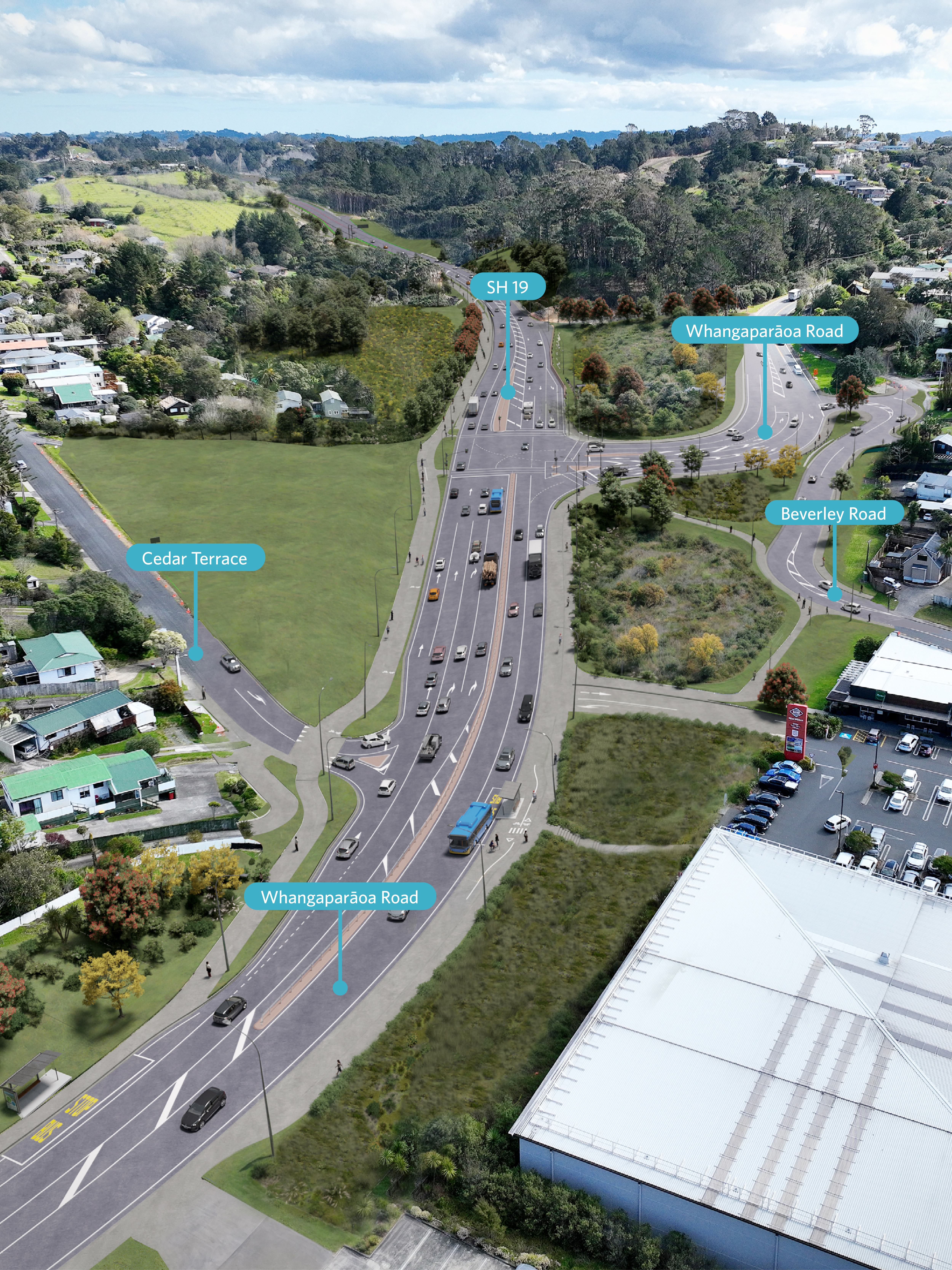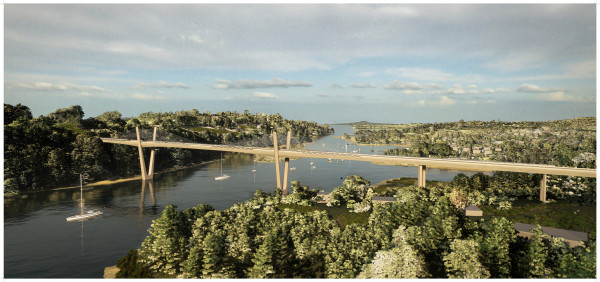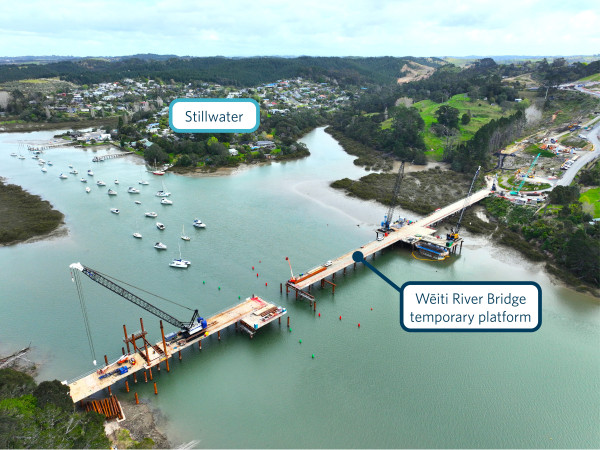General Arrangement
View the general arrangement plans [PDF, 8.5 MB]
Additional plans including intersection design plans:
O Mahurangi – Penlink publications(external link)
Whangaparāoa intersection design
The Whangaparāoa intersection is designed to improve safety and traffic flow, as well as enhance stormwater management:
- On Whangaparāoa Road, we added another westbound lane after Cedar Terrace. This ensures future-proofed capacity for vehicles travelling from further up the peninsula.
- Only left turns in and out of Cedar Terrace to prevent unsafe right turns on and off Whangaparāoa Road.
- Extra lane length on Whangaparāoa Road for vehicles turning right to local roads (such as Wiriana Place or Beverley Road).

Artist concept of the new SH19 and Whangaparāoa Road intersection.
Construction
People can continue to use Whangaparāoa Road during construction. The new road layout is being built ‘offline,’ next to the existing Whangaparāoa Road. Some impacts are expected when transporting goods to site and later when connecting the new road to existing infrastructure.
Stormwater
Stormwater wetlands will capture and treat stormwater run-off from road surfaces. This reduces the risk of flooding in this low-lying area. Currently, flood waters overtop Whangaparāoa Road in a one in 10-year storm event. The new design will keep the intersection operating during a one in 100-year event. The wetland areas will feature ponds, landscaping and pathways.
Wēiti River Bridge
The Wēiti River Bridge is an extradosed bridge. An extradosed bridge is a hybrid between a box girder and cable-stayed bridge designs. It will be the first of its kind in Aotearoa New Zealand.

Indicative view of the Wēiti River Bridge, connecting Stillwater to Whangaparāoa.
Wēiti River Bridge design
The box girder element means it can carry a range of services and utilities, such as power and water, to the Whangaparāoa Peninsula. There’s even space for a future sewer main. The cables allow for a longer bridge span than the ‘balanced cantilever’ bridge in the project’s reference design. This reduces the number of piers needed to support the bridge and thus reduces the impact on the river below.
The span arrangement achieved with an extradosed bridge also enables the piers to be clear of the navigable waterway. Its position is more respectful of ecological and cultural site constraints.
We updated the Wēiti River Bridge design to deliver more benefits:
- Reducing the number of piers from three to two and removing the centre pier allows clearer views and passage through the navigation channel.
- Avoid cliff face excavation by removing the need for a pier on the eastern bank of the Wēiti River.
- Minimise greenhouse gas emission by improving construction methodologies.
- Reduce construction emissions by reducing materials
- Improve the overall amenity by lowering the entrance of the bridge so it fits better within the landscape.
Western temporary platform
Construction of the temporary platform on the western side of Wēiti River is underway. This platform will enable us to build the Wēiti River Bridge. Noise will be heard on both sides of the river during this work. Works on the Whangaparāoa side of the river will be more noticeable to residents on the Peninsula.

Sustainability
Toitūtanga – sustainability
2024 O Mahurangi – Penlink sustainability annual report [PDF, 2.4 MB]
2023 O Mahurangi – Penlink sustainability annual report summary [PDF, 529 KB]
The O Mahurangi Alliance is committed to delivering environmental and social outcomes as part of the design, construction and operation of this project, and are aiming to achieve an ‘Excellent’ Infrastructure Sustainability rating for the Design and As-built phases.
The Infrastructure Sustainability Council (ISC) is the peak industry body for advancing sustainability outcomes in infrastructure. ISC rating scheme is a comprehensive rating scheme for evaluating sustainability across design, construction and operation of Infrastructure. The ISC rating scheme aims to:
- Provide a common national language for sustainability in infrastructure.
- Provide a framework for consistent application and evaluation of sustainability in tendering processes.
- Help in scoping whole-of-life sustainability risks for projects and assets, enabling smarter solutions that reduce risks and costs.
- Foster efficiency and waste reduction, reducing costs.
- Foster innovation and continuous improvement in the sustainability outcomes from infrastructure.
- Build an organisation’s credentials and reputation in its approach to sustainability outcomes.
ISC rating scheme(external link)
Resource efficiency, waste minimisation
O Mahurangi – Penlink represents a significant opportunity to change the way that transport infrastructure projects are delivered, particularly in how we view and use resources and waste, are we are committed to leaving a legacy in the community and wider industry.
For the duration of the project we will demonstrate a sustained focus on optimising what we use, how we use it and the whole of life impacts of resources.
O Mahurangi – Penlink’s approach aligns with the NZTA definition of resource efficiency: “to achieve the best possible output for the least volume of materials and energy consumed during the construction, operation and maintenance of the land transport system, while providing relevant levels of service for safety, speed, environment and amenity.”
Te Hiringa o Te Taiao – Our Resource Efficiency Strategy was published in June 2021 and in February 2022 NZTA released their Resource Efficiency Policy for Infrastructure Delivery & Maintenance. Our geometric alignment and earthworks strategy minimises cut to waste and reduces carbon, as well as lowering cost and increasing production efficiency. Re-using and re-purposing materials wherever possible and managing and sorting all waste on-site signals a shift in the way we value resources. We will extend this by working closely with the supply chain to positively influence both efficient use of resources and minimisation of waste. This project can be a catalyst for industry change in the delivery of transport infrastructure in both resource efficiency and the treatment of waste as a valuable resource.
Resource Efficiency Policy for Infrastructure Delivery & Maintenance [PDF, 217 KB]
During the design and construction phases, we will continue to focus on resource efficiency so that it is deeply embedded into our team culture. We will seek to minimise wherever possible the impacts of resource use in terms of the volume of material and energy consumption required.
